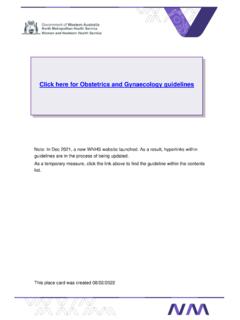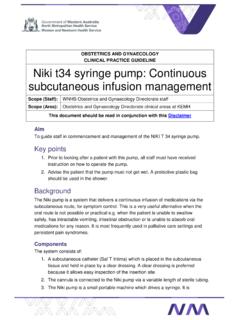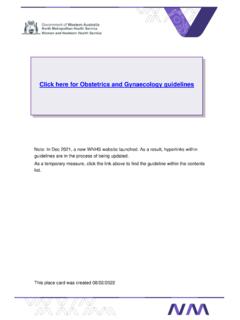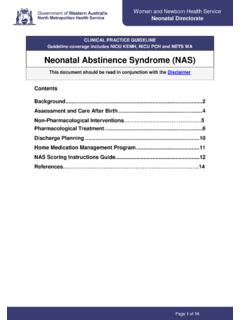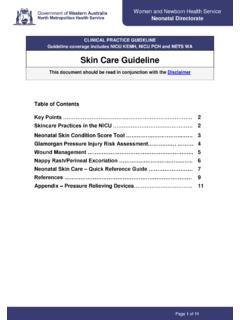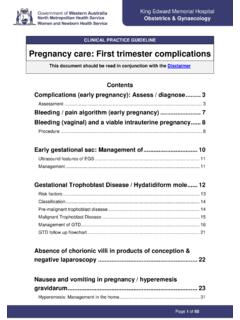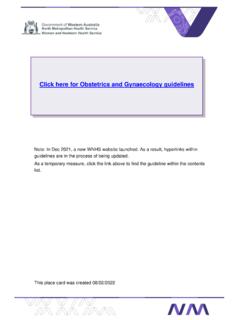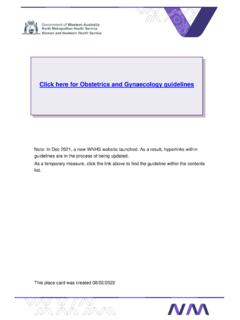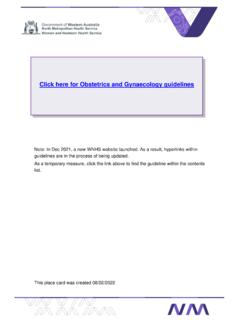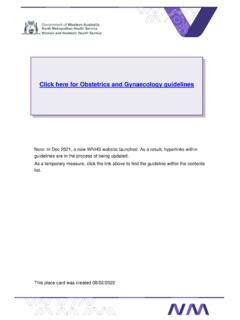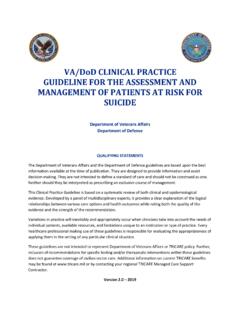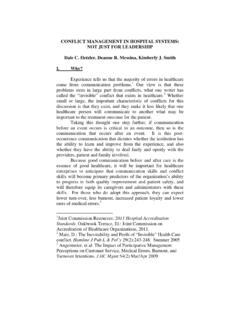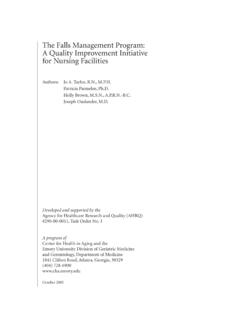Transcription of Hypertension in Pregnancy: Medical Management of
1 Page 1 of 26 King Edward Memorial Hospital Obstetrics & Gynaecology Contents Medical Management .. 2 Key 2 Definitions .. 2 Recording Blood pressure in pregnancy .. 4 Classification of Hypertension in pregnancy .. 4 Risk Factors for Pre Eclampsia1, 16 .. 6 Investigation Of New Onset Hypertension after 20 Weeks Gestation .. 6 Assessment of Severity in Pre Eclampsia .. 8 Management of pre-eclampsia and gestational 8 Outpatient Management .. 10 Inpatient Management .. 11 Special Management issues for hypertensive crises (BP of 170/110).. 11 Drug Therapy .. 12 Fetal surveillance in pregnant women with Hypertension .. 15 Eclampsia .. 15 Management of eclampsia .. 15 Prevention of eclampsia in the woman with preeclampsia .. 16 Administration of Magnesium Sulphate.
2 16 HELLP syndrome .. 17 Management of HELLP Syndrome .. 18 Chronic Hypertension .. 19 Baseline assessments .. 19 Oral Drug Therapy .. 20 Post-partum Management of women with chronic Hypertension .. 20 Chronic Hypertension with superimposed preeclampsia .. 20 Preconception counselling .. 21 Key points .. 21 Significant risk factors for developing pre-eclampsia57 .. 21 Risk factors associated with preeclampsia6 .. 21 Women recommended to attend preconception counselling .. 22 Management Strategies for prevention of pre-eclampsia .. 22 References .. 23 CLINICAL PRACTICE GUIDELINE Hypertension in pregnancy: Medical Management This document should be read in conjunction with the Disclaimer Hypertension : Medical Management Page 2 of 26 Obstetrics & Gynaecology Medical Management Aim The aim of this guideline is to standardise the approach to the Management of severe pre-eclampsia and eclampsia in the immediate pre- and post- delivery interval in order to improve the outcome for the mother and child1.
3 Background Hypertensive disorders during pregnancy occur in women with pre-existing primary or secondary chronic Hypertension , and in women who develop new-onset Hypertension in the second half of pregnancy. Hypertensive disorders during pregnancy carry risks for the woman and the baby. Although the rate of eclampsia in the United Kingdom (UK) appears to have fallen, Hypertension in pregnancy remains one of the leading causes of maternal death in the UK2. In Western Australia alone, Hypertension occurs in of all pregnancies, % due to Pre-Eclampsia and due to Essential Hypertension . % of Perinatal Deaths are due to Hypertension in pregnancy3, 4. Key Point Transfer to a tertiary setting is indicated for: All pre term pregnancies with severe pre eclampsia, eclampsia or HELLP syndrome All term pregnancies complicated by eclampsia or HELLP syndrome Any pregnancy in which the health care provider believes his/her health care facility would be unable to manage the complications of Hypertension in pregnancy.
4 Note: MgSO4 therapy should be considered prior to transfer in women with severe pre eclampsia, eclampsia or HELLP syndrome5, provided that the women will be accompanied in transfer by a Medical Practitioner (in case of respiratory arrest). For women who are having antenatal care in a community setting, CMP if systolic blood pressure is 140-160 or diastolic 90-100, recheck in 15minutes. If the blood pressure remains high then consult and refer to support hospital for assessment and plan. If the woman s blood pressure is above 160 systolic or 100 diastolic then consult and recommend transfer to support hospital via ambulance. Definitions Hypertension in pregnancy6 1. Systolic blood pressure greater than or equal to 140 mmHg and/or 2. Diastolic blood pressure greater than or equal to 90 mmHg (Korotkoff 5) These measurements should be confirmed by repeated readings over several hours6.
5 Hypertension : Medical Management Page 3 of 26 Obstetrics & Gynaecology Normal pregnancy is characterized by a fall in blood pressure, detectable in the first trimester and usually reaching a nadir in the second trimester. Blood pressure rises towards pre-conception levels towards the end of the third trimester. Detecting a rise in blood pressure from booking or preconception blood pressure (> 30/15 mmHg), rather than relying on an absolute value, has in the past been considered useful in diagnosing pre-eclampsia in women who do not reach systolic blood pressures of 140 mmHg or diastolic blood pressures of 90 mmHg6. Available evidence however, does not support the notion that these women have an increased risk of adverse , 8 Nevertheless such a rise may be significant in some women, particularly in the presence of hyperuricemia and proteinuria.
6 Further data are required and in the meantime, closer monitoring of pregnant women with an increment in blood pressure of 30 mmHg systolic and/or 15 mmHg diastolic is appropriate. Severe Hypertension in pregnancy Systolic blood pressure greater than or equal to 170 mmHg and/or diastolic blood pressure greater than or equal to 110 mmHg. This represents a level of blood pressure above which the risk of maternal morbidity and mortality is increased. It is generally acknowledged that severe Hypertension should be lowered promptly, albeit carefully, to prevent cerebral haemorrhage and hypertensive encephalopathy6, 9. This degree of Hypertension requires urgent assessment and Management . It is important to acknowledge that systolic as well as diastolic Hypertension increases the risk of cerebral haemorrhage.
7 White Coat Hypertension Defined as Hypertension in a clinical setting with normal blood pressure away from this setting when assessed by 24 hour ambulatory blood pressure monitoring or home blood pressure monitoring using an appropriately validated device. Women with this condition present early in pregnancy with apparent chronic Hypertension , but their outcomes are better than those of women with true chronic Hypertension . They may generally be managed without medication by using repeated ambulatory or home blood pressure monitoring. A small proportion will go on to develop preeclampsia10. Proteinuria Defined as the urinary excretion of g protein in a 24-hour specimen. This will usually correlate with 30 mg/dL ( 1+ reading on dipstick) in a random urine determination with no evidence of urinary tract infection9, 11.
8 Oedema Oedema is no longer included in the definition of pre-eclampsia as it occurs equally in women with and without this condition. Nevertheless rapid development of generalised oedema should alert the clinician to screen for preeclampsia6. Hypertension : Medical Management Page 4 of 26 Obstetrics & Gynaecology Recording Blood pressure in pregnancy The woman should be seated comfortably with her legs resting on a flat surface. In labour, the blood pressure may be measured in the left arm in lateral recumbency. The supine posture should be avoided because of the supine hypotension syndrome. Measurement of blood pressure should be undertaken in both arms at the initial visit to exclude rare vascular abnormalities such as aortic coarctation, subclavian stenosis and aortic dissection.
9 Generally the variation in blood pressure between the upper limbs should be less than 10 mmHg. The systolic blood pressure is accepted as the first sound heard (K1) and the diastolic blood pressure the disappearance of sounds completely (K5)(8-10). Where K5 is absent, K4 (muffling) should be accepted. Correct cuff size is important for accurate blood pressure recording. A large cuff with an inflatable bladder covering 80% of the arm circumference should be used if the upper arm circumference is greater than 33 cm. This helps to minimise over-diagnosis of Hypertension during pregnancy 6, 12, 13. Classification of Hypertension in pregnancy This classification of the hypertensive disorders in pregnancy reflects the pathophysiology of the constituent conditions as well as the risks and potential outcomes for both mother and baby.
10 The following clinical classification has been adopted by numerous International and National bodies, differing predominantly in whether they require proteinuria or not for the diagnosis of pre eclampsia. The International Society for the Study of Hypertension in Pregnancy (ISSHP) guideline no longer requires proteinuria for the diagnosis of pre eclampsia, leaving on the British NICE guideline with this requirement17. The classification is as follows: Preeclampsia eclampsia Gestational Hypertension Chronic Hypertension essential secondary white coat Preeclampsia superimposed on chronic hypertension6, 14 Pre eclampsia This is a multi-system disorder characterised by Hypertension and involvement of one or more other organ systems and/or the fetus.
